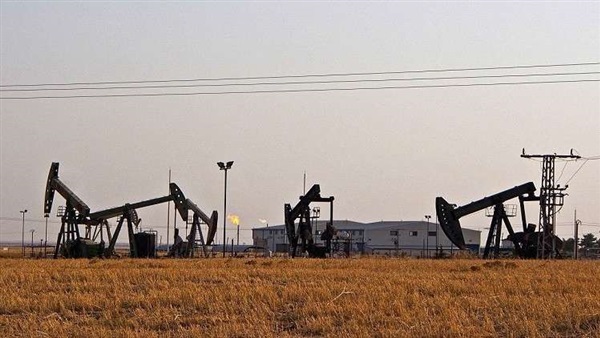Russia, Iran Vie for Syrian Oil ‘Leftovers’

The behind-the-scenes scrap between Russia and Iran over oil wealth in northeastern Syrian regions, which are not held by the Kurdish Syrian Democratic Forces (SDF), has intensified.
Before
the eruption of the crisis in 2011, Syria used to produce around 360,000
barrels of oil per day. It now stands at 80,000 bpd.
On
Thursday, Minister of Oil and Mineral Resources Bassam Tohme revealed that
direct and indirect losses in the sector have exceeded 92 billion dollars. He
added that more than 90 percent of the country’s oil reserves are controlled by
the United States and their SDF allies in regions east of the Euphrates River.
These regions also boast Syria’s most important gas factories and the majority
of its agricultural and water wealth.
Qamishli
allies
Oil
produced in areas east of the Euphrates is either locally used or sent through
warlords to the Homs or Baniyas refineries in government-held regions. They are
then either returned to the Kurdish-controlled region or used in regime regions.
Some
of the oil is also smuggled to Iraqi Kurdistan and later Turkey to provide
financial revenues to prop up the autonomous Kurdish administration east of the
Euphrates. Observers believes these operations provide some 400 million dollars
annually that go to supporting the administration and its 100,000 SDF fighters
and policemen.
Western
sanctions have targeted mediators between Damascus and Qamishli, as well as
Syria’s entire oil sector.
The
autonomous administration and American companies have, meanwhile, discussed oil
investments. In April 2020, the US Treasury Department granted a rare license
allowing little known Delta Crescent Energy to operate in the country.
The
company, incorporated in Delaware in 2019, was founded by former Delta Force
officer James Reese, former US Ambassador to Denmark James Cain, and John P.
Dorrier Jr., a former executive at GulfSands Petroleum, a UK-based oil company
that had previously worked in northeastern Syria.
In
July, Republican Senator Lindsey Graham said that SDF General Commander Mazloum
Abdi informed him that a deal had been signed with an American company to
“modernize the oil fields in northeastern Syria”.
The
deal was slammed by Damascus, Moscow, Tehran and Ankara. Tohme said the
agreement sought to “steal” the Syrian people’s resources.
Former
US President Donald Trump said that he was keeping American forces in Syria to
protect oil wells and prevent ISIS from capturing them.
Damascus’
allies
Damascus
has sought to cut its losses by obtaining oil derivatives from Iran. These
naval shipments have, however, been intercepted by the US and Israel. The
latest such obstruction took place on Wednesday when a vessel loaded with
derivates was barred from reaching Syrian ports.
As
Syria is in the grips of a stifling economic crisis and western sanctions,
Russia and Iran’s attention has shifted towards investing in oil and gas fields
that remain under Damascus’ control. Syria also boasts phosphates reserves.
In
2017, Damascus and Tehran signed four strategic deals for the Iran
Revolutionary Guards to run a third mobile phone operator, invest in phosphates
for the next 99 years, seize agricultural and industrial lands and set up an
oil port on the Mediterranean.
In
September 2020, Russia and Syria held a series of meetings aimed at bolstering
economic relations. They also upped their military cooperation and deployment
at the Latakia and Tartus bases. Soon after Russia’s military intervention in
Syria in 2015, it signed an agreement with Damascus that would allow Wagner
mercenaries to protect and liberate oil and gas installations from ISIS. In
return, it would receive 25 percent of their revenues.
Estimates from 2018 said that some 2,500 Wagner operatives and some 20,000 to 25,000 Iran-backed militants were present in Syria.
With
the fighting dying down in March 2020, the race between Russia and Iran to
claim Syrian sovereign rights intensified. Iranian militants, as well as the
Lebanese Hezbollah and Fatemiyoun fighters from Iraq, have seized the oil and
gas fields in the Deir Ezzor and Raqqa countrysides. Pro-Russia forces have,
however, sought to expel them.
Russia
has sought to obtain oil investment contracts in the Mediterranean. Damascus
approved an agreement granting a Russian firm exclusive rights to drill for oil
in Syria’s offshore bloc in its exclusive economic zone off that stretches from
off the coast of Tartus to the border with Lebanon. The deal lasts 29 years.
Iran
still controls the Alboukamal oil wells, which it captured in 2017. It also
controls phosphate mines in the Palmyra countryside in spite of repeated
attempts by Moscow to seize them.
American
officials believe that Russia and Iran’s race for Syria’s resources will grant
them a crucial negotiations card when it comes to the war-torn country’s
future.





